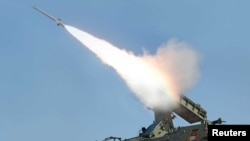A U.S. research group said a cruise missile appears to be the latest addition to North Korea's increasingly advanced arsenal.
The U.S.-Korea Institute at Johns Hopkins University spotted the new missile in a brief shot buried within a North Korean military propaganda video.
It said the the cruise missile is a sea-based copy of the Russian-made, anti-ship Kh-35, which can be launched from ships, helicopters, or land.
The institute, which published the findings on its 38 North blog, said Pyongyang most likely acquired the missile through direct sale from Russia.
It said North Korea could have also obtained the cruise missile through a third party such as Burma, which is also known as Myanmar.
Any such deal would be in violation of United Nations sanctions on North Korea's nuclear and missile programs.
In recent years, North Korea has carried out three nuclear tests, as well as a series of short-, medium- and long-range ballistic missile tests.
The report's author, Jeffrey Lewis, said modern cruise missiles would be a "new and potentially destabilizing addition to North Korea's missile arsenal."
He said there are also concerns North Korea could sell the Kh-35 cruise missile technology to others, as it has with the Soviet-made Scud missile.
Guided cruise missiles travel at a lower trajectory and generally are more accurate than ballistic missiles, which are guided only during their initial powered phase of flight.
The U.S.-Korea Institute at Johns Hopkins University spotted the new missile in a brief shot buried within a North Korean military propaganda video.
It said the the cruise missile is a sea-based copy of the Russian-made, anti-ship Kh-35, which can be launched from ships, helicopters, or land.
The institute, which published the findings on its 38 North blog, said Pyongyang most likely acquired the missile through direct sale from Russia.
It said North Korea could have also obtained the cruise missile through a third party such as Burma, which is also known as Myanmar.
Any such deal would be in violation of United Nations sanctions on North Korea's nuclear and missile programs.
In recent years, North Korea has carried out three nuclear tests, as well as a series of short-, medium- and long-range ballistic missile tests.
The report's author, Jeffrey Lewis, said modern cruise missiles would be a "new and potentially destabilizing addition to North Korea's missile arsenal."
He said there are also concerns North Korea could sell the Kh-35 cruise missile technology to others, as it has with the Soviet-made Scud missile.
Guided cruise missiles travel at a lower trajectory and generally are more accurate than ballistic missiles, which are guided only during their initial powered phase of flight.









